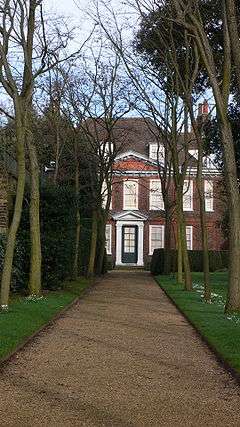Fenton House
| Fenton House | |
|---|---|
 The house in winter 2006 | |
| General information | |
| Type | Merchant's house |
| Location |
Hampstead London, NW3 United Kingdom |
| Coordinates | 51°33′32.01″N 0°10′46.85″W / 51.5588917°N 0.1796806°WCoordinates: 51°33′32.01″N 0°10′46.85″W / 51.5588917°N 0.1796806°W |
| Completed | 17th century |
| Owner | National Trust |
| Technical details | |
| Material | Brick |
| Designations | Grade I listed[1] |
Fenton House is a 17th-century merchant's house in Hampstead in North London which belongs to the National Trust, bequeathed to them in 1952 by Lady Binning, its last owner and resident. It is a detached house with a walled garden, which is large by London standards, and features roses, an orchard and a working kitchen garden. The interior houses the Benton Fletcher collection of early keyboard instruments, some of which are often played for visitors during operational hours, and collections of paintings (including the collection of Peter Barkworth, and loans of Sir William Nicholson paintings), porcelain, 17th-century needlework pictures and Georgian furniture. It also has fine portraits of Dorothea Jordan, William IV, George IV, Frederick FitzClarence and Adolphus Fitzclarence - one of Jordan's daughters by William IV lived in the house.
The 17th-century brick mansion has a 300-year-old orchard, where around 30 types of apple trees flourish. Apple day, held in late September every year, gives members of the general public the opportunity to savor some of its rare and delicious apples, along with other goodies like apple-blossom honey.
References
- ↑ Historic England. "Fenton House (Grade I) (1378648)". National Heritage List for England. Retrieved 27 January 2015.
External links
| Wikimedia Commons has media related to Fenton House. |